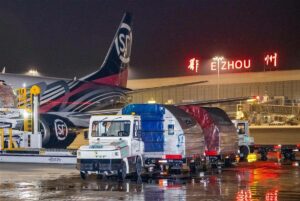Sep 18, 2023

In 2022, Ezhou Huahu Airport opened its doors with the core mission of collaboratively establishing the air cargo hub layout alongside comprehensive hub airports.
As the world’s fourth and Asia’s first professional cargo airport, it has rapidly emerged as a key hub, connecting the key market to the rest of the world. It also shoulders the responsibility of reshaping the global aviation logistics framework and fostering the creation of a world-class supply chain centre.
“The opening of Ezhou Huahu Airport enables China to have a large-scale air cargo hub of international standard, making up for China as the most important world factory in the global industrial chain, but there is in the absence of a correspondingly competitive international air cargo network,” Luo Guowei, Party Secretary and Chairman of Hubei International Logistics Airport Co. Ltd. said.
Multimodal connectivity
By June 2022, China had a total of 250 transportation airports, but none were predominantly focused on cargo operations. Especially in the airfreight space, with the rise of e-commerce and express logistics, China’s lack of a professional cargo airport was exposed.
“Accelerating the construction of cargo function-based airports was an important task we faced,” Guowei explained. “Ezhou Airport helps to improve the layout of China’s aviation industry and make up for the shortcoming.”
One of the main motivations behind developing Ezhou Airport is its strategic location despite being in a landlocked province. The airport’s proximity to key transportation corridors allows it to seamlessly integrate with high-speed rail and ports, creating a comprehensive transportation corridor that spans air, land, and water transport.
“This airport plays a crucial role in realising the interconnected “three port” synergy spanning air, land, and water transport, giving rise to an expansive transportation blueprint featuring aviation and fortified by an underlying network of railways and roads, which is further extended through maritime transport,” Guowei highlighted.
“Ezhou Airport remains steadfast in its commitment to the principles of “consolidation, enhancement, refinement, and fluidity,” and will focus on improving aviation support capabilities and industrial chain level,” Guowei continued.
Catalyst for economic development
Ezhou Airport’s significance extends beyond logistics; it plays a pivotal role in advancing China’s economic development strategies. As part of the Belt and Road initiative, the airport aligns with the economic development requirements of countries along the Silk Road Economic Belt and the 21st Century Maritime Silk Road.
“The new era emphasises linking China and the countries along “the Belt and Road” through aviation cargo transportation,” Guowei said. “The demand for air cargo is surging within China’s economic and trade collaborations with 65 countries along this route to turn Ezhou into China’s Memphis.”
Additionally, the rise of e-commerce has fuelled the need for efficient cargo operations, positioning Ezhou Airport as a critical player in powering operations within the region and beyond.
“Internationally, the construction and operation of Ezhou Huahu Airport stands to augment the global competitiveness of China’s air cargo sector, facilitating its stride to catch up with international giants such as FedEx, and take the lead in the global middle and high-end market,” Guowei stated.
Tailor made terminal
Ezhou Airport boasts state-of-the-art facilities tailored for cargo operations. With its well-planned terminal and runway system, including class 4E flight areas and long-distance runways, the airport can accommodate large aircraft like the B747-8.
The airport’s current phase has been completed in accordance with the target of the terminal area to meet 1 million passengers and 2.45 million tonnes of cargo and mail throughput in 2025, and the flight area runway system to meet 1.5 million passengers and 3.3 million tonnes of cargo and mail throughput in 2030.
“Through the integration of automated sorting systems, automatic identification systems, handheld terminals, and integrated device systems, rapid and precise management and sorting of goods can be realised,” Guowei said.
The airport has a 750,000-square-metre cargo sorting centre with 23,000 sets of sorting equipment and an annual handling capacity of 635 million pieces; a 15,000-sq m passenger terminal, and a 24,000-sq m domestic cargo terminal.
“The application of machinery and artificial intelligence to facilitate automated operations effectively tackles labour costs and enhances logistical efficiency,” Guowei highlighted. “Automated sorting machines are set to emerge as a pivotal element in elevating efficiency within industrial production and the circulation of commercial trade.”
International interaction
The vision for the Ezhou hub is the construction of a modern logistics platform with international impact, while its core strength will lie in providing the fastest and most comprehensive logistics options for any goods – anywhere, any time.
Its development objective is rooted in being anchored in Ezhou, encompassing the entirety of China’s Hubei province, and extending across the nation to offer global services.
Guided by the demands of the cargo market, this hub aspires to bridge gaps and address any weaknesses in China’s aviation cargo infrastructure, enhance international aviation cargo capabilities, and construct an air cargo hub with global competitiveness.
“Etihad Cargo’s inaugural flight signifies a joint endeavour between Ezhou Airport and international airlines to develop international routes and enhance competitiveness against global airports; establishing a significant new milestone in history for local governance to attract noteworthy partnerships,” Guowei said.
Leveraging this momentum, Ezhou Huahu Airport is accelerating the development of the “Aero-City” concept, proactively enticing both domestic and international carriers to put into operation.
Together, these efforts aim to elevate Ezhou Huahu Airport into a globally influential international cargo hub, collectively contributing to the establishment of an open inland hub and the advancement of central China.
2025 vision
With the continuous optimisation of anti-pandemic measures, the domestic macroeconomy is witnessing a gradual recovery, and both SF Airlines and Etihad Cargo have launched Ezhou-Abu Dhabi direct freight routes.
This move serves a dual purpose: on the one hand, it stimulates the development of domestic and international air cargo trade; on the other hand, it accelerates the development and operation of the international all-freight market. This lays the foundation for the gradual resumption and opening up of international air logistics corridors that span the globe, and makes substantial efforts to fortify air transport capacity and operational efficiency, and continues to ensure the seamlessness and security of air logistics transportation.
As the only professional cargo airport approved for construction in China, it is projected that approximately 10 international cargo routes and 50 domestic cargo routes will be operational from Ezhou by 2025.
“This joint effort not only boosts the development of the Wuhan Metropolitan Area, but also facilitates Hubei’s integration into the “dual circulation” development framewor. These initiatives contribute towards the objective of cultivating a pioneering region for the construction of new national development dynamics, and ultimately evolving into a significant new growth catalyst for the Chinese economy.”
The post A new chapter in air cargo logistics appeared first on AIR CARGO WEEK.
Go to Source
Author: Edward Hardy




